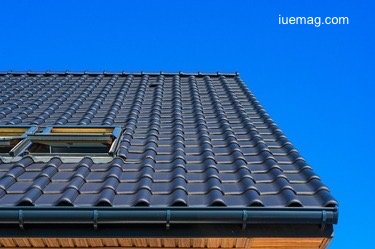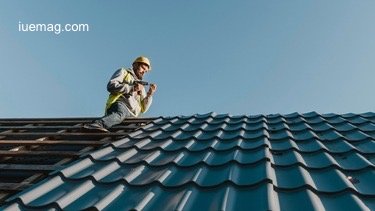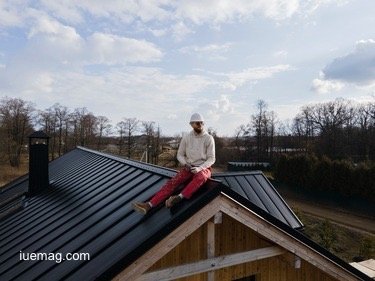

Roofing Trends and Innovations: Insights from Leading Contractors
In today's dynamic construction environment, roofing holds immense significance, serving as more than just a protective covering but also as a key element in defining the visual appeal and functionality of a structure. The continuous evolution of roofing trends and innovations acts as a catalyst for transformation within the industry, compelling contractors and every commercial roofing company to adopt progressive methodologies and materials.
 For ContractorsIn Roofing & Waterproofing, remaining at the forefront of these advancements is not merely advantageous but essential to ensure the delivery of exceptional services. Let's embark on a journey through the contemporary roofing landscape, where we'll uncover invaluable insights gleaned from industry leaders who are pioneering change and shaping the future of roofing practices.
For ContractorsIn Roofing & Waterproofing, remaining at the forefront of these advancements is not merely advantageous but essential to ensure the delivery of exceptional services. Let's embark on a journey through the contemporary roofing landscape, where we'll uncover invaluable insights gleaned from industry leaders who are pioneering change and shaping the future of roofing practices.
Sustainability has become a cornerstone in various industries, and roofing is no exception. Sustainable roofing materials offer an eco-friendly alternative while maintaining durability and performance. Contractors are increasingly turning towards these options to meet the demands of environmentally conscious clients.
Introducing sustainable materials to the roofing market not only reduces the environmental footprint but also enhances the longevity of structures. Materials like recycled metal, reclaimed wood, and green roofs are gaining traction for their eco-friendly attributes. These materials not only offer durability but also contribute to energy efficiency and insulation, making them a preferred choice for modern construction projects.
Moreover, sustainable roofing materials often boast superior resistance to weather elements, thereby extending the lifespan of roofs and reducing maintenance requirements. For instance, metal roofing murfreesboro, especially recycled metal roofing, is renowned for its durability and ability to withstand harsh climates, making it a popular choice for both residential and commercial properties. Additionally, green roofs, which feature vegetation and soil layers, provide natural insulation, regulate temperature, and improve air quality, contributing to healthier and more sustainable urban environments.
 Advancements in technology have revolutionised the roofing industry, enabling contractors to streamline processes and enhance project outcomes. Integrating drones for aerial inspections, thermal imaging for leak detection, and software solutions for project management have become standard practices among leading contractors.
Advancements in technology have revolutionised the roofing industry, enabling contractors to streamline processes and enhance project outcomes. Integrating drones for aerial inspections, thermal imaging for leak detection, and software solutions for project management have become standard practices among leading contractors.
The benefits of incorporating technology into roofing projects are manifold. From improving accuracy in measurements to reducing project timelines, these advancements boost efficiency and productivity. Drones, equipped with high-resolution cameras and sensors, enable contractors to conduct thorough inspections of roofs, identifying potential issues such as leaks, cracks, and structural damage with precision and speed.
Furthermore, thermal imaging technology allows for non-invasive detection of moisture and insulation deficiencies, facilitating proactive maintenance and preventing costly repairs down the line. By leveraging software solutions for project management and communication, contractors can streamline collaboration, track progress, and ensure seamless coordination among team members, subcontractors, and clients.
Energy efficiency has emerged as a key consideration in roofing projects, driven by the need for sustainable and cost-effective solutions. Contractors are increasingly implementing innovations that reduce energy consumption and enhance thermal performance, thereby improving the overall efficiency of buildings.
Innovations such as cool roofs, which reflect sunlight and absorb less heat, help mitigate urban heat island effects and reduce cooling costs. Additionally, advancements in insulation materials and techniques enhance thermal resistance, maintaining comfortable indoor temperatures while minimising energy usage. By adopting these energy-efficient roofing solutions, contractors not only contribute to environmental conservation but also provide long-term value to clients through reduced utility expenses.
 Beyond functionality, roofing serves as a prominent architectural element that significantly impacts the overall aesthetic of a structure. Design trends in roofing continue to evolve, reflecting shifts in architectural preferences and consumer demands. Contractors play a pivotal role in translating these trends into tangible roofing solutions that blend functionality with visual appeal.
Beyond functionality, roofing serves as a prominent architectural element that significantly impacts the overall aesthetic of a structure. Design trends in roofing continue to evolve, reflecting shifts in architectural preferences and consumer demands. Contractors play a pivotal role in translating these trends into tangible roofing solutions that blend functionality with visual appeal.
From sleek and minimalist designs to intricate patterns and textures, roofing aesthetics have witnessed a diverse range of trends. Materials like metal roofing, with its versatility and modern appeal, have become synonymous with contemporary architecture. Additionally, eco-conscious designs incorporating living roofs and vegetative systems are gaining popularity for their sustainable attributes and natural beauty.
Remaining cognizant of the latest roofing trends and innovations stands as an imperative for ContractorsIn Roofing & Waterproofing to uphold their commitment to excellence and maintain a competitive edge in the market. Embracing sustainable materials not only aligns with eco-conscious clients' preferences but also underscores dedication to reducing environmental impact while ensuring durability and performance.
Moreover, integrating advanced technologies into roofing practices enhances efficiency and precision, streamlining processes and elevating project outcomes. Energy-efficient solutions not only fulfill regulatory requirements but also contribute to cost savings and environmental sustainability, reflecting a forward-thinking approach to construction.
By embracing these pillars of innovation, expertise, and a dedication to excellence, leading contractors serve as trailblazers in reshaping the roofing industry. Their endeavours pave the way for the adoption of sustainable, efficient, and aesthetically pleasing roofing solutions, driving progress towards a more resilient and environmentally conscious built environment.
 For ContractorsIn Roofing & Waterproofing, remaining at the forefront of these advancements is not merely advantageous but essential to ensure the delivery of exceptional services. Let's embark on a journey through the contemporary roofing landscape, where we'll uncover invaluable insights gleaned from industry leaders who are pioneering change and shaping the future of roofing practices.
For ContractorsIn Roofing & Waterproofing, remaining at the forefront of these advancements is not merely advantageous but essential to ensure the delivery of exceptional services. Let's embark on a journey through the contemporary roofing landscape, where we'll uncover invaluable insights gleaned from industry leaders who are pioneering change and shaping the future of roofing practices.Sustainable Roofing Materials
Sustainability has become a cornerstone in various industries, and roofing is no exception. Sustainable roofing materials offer an eco-friendly alternative while maintaining durability and performance. Contractors are increasingly turning towards these options to meet the demands of environmentally conscious clients.
Introducing sustainable materials to the roofing market not only reduces the environmental footprint but also enhances the longevity of structures. Materials like recycled metal, reclaimed wood, and green roofs are gaining traction for their eco-friendly attributes. These materials not only offer durability but also contribute to energy efficiency and insulation, making them a preferred choice for modern construction projects.
Moreover, sustainable roofing materials often boast superior resistance to weather elements, thereby extending the lifespan of roofs and reducing maintenance requirements. For instance, metal roofing murfreesboro, especially recycled metal roofing, is renowned for its durability and ability to withstand harsh climates, making it a popular choice for both residential and commercial properties. Additionally, green roofs, which feature vegetation and soil layers, provide natural insulation, regulate temperature, and improve air quality, contributing to healthier and more sustainable urban environments.
Advanced Roofing Technologies
 Advancements in technology have revolutionised the roofing industry, enabling contractors to streamline processes and enhance project outcomes. Integrating drones for aerial inspections, thermal imaging for leak detection, and software solutions for project management have become standard practices among leading contractors.
Advancements in technology have revolutionised the roofing industry, enabling contractors to streamline processes and enhance project outcomes. Integrating drones for aerial inspections, thermal imaging for leak detection, and software solutions for project management have become standard practices among leading contractors.The benefits of incorporating technology into roofing projects are manifold. From improving accuracy in measurements to reducing project timelines, these advancements boost efficiency and productivity. Drones, equipped with high-resolution cameras and sensors, enable contractors to conduct thorough inspections of roofs, identifying potential issues such as leaks, cracks, and structural damage with precision and speed.
Furthermore, thermal imaging technology allows for non-invasive detection of moisture and insulation deficiencies, facilitating proactive maintenance and preventing costly repairs down the line. By leveraging software solutions for project management and communication, contractors can streamline collaboration, track progress, and ensure seamless coordination among team members, subcontractors, and clients.
Energy-Efficient Roofing Solutions
Energy efficiency has emerged as a key consideration in roofing projects, driven by the need for sustainable and cost-effective solutions. Contractors are increasingly implementing innovations that reduce energy consumption and enhance thermal performance, thereby improving the overall efficiency of buildings.
Innovations such as cool roofs, which reflect sunlight and absorb less heat, help mitigate urban heat island effects and reduce cooling costs. Additionally, advancements in insulation materials and techniques enhance thermal resistance, maintaining comfortable indoor temperatures while minimising energy usage. By adopting these energy-efficient roofing solutions, contractors not only contribute to environmental conservation but also provide long-term value to clients through reduced utility expenses.
Design Trends in Roofing
 Beyond functionality, roofing serves as a prominent architectural element that significantly impacts the overall aesthetic of a structure. Design trends in roofing continue to evolve, reflecting shifts in architectural preferences and consumer demands. Contractors play a pivotal role in translating these trends into tangible roofing solutions that blend functionality with visual appeal.
Beyond functionality, roofing serves as a prominent architectural element that significantly impacts the overall aesthetic of a structure. Design trends in roofing continue to evolve, reflecting shifts in architectural preferences and consumer demands. Contractors play a pivotal role in translating these trends into tangible roofing solutions that blend functionality with visual appeal.From sleek and minimalist designs to intricate patterns and textures, roofing aesthetics have witnessed a diverse range of trends. Materials like metal roofing, with its versatility and modern appeal, have become synonymous with contemporary architecture. Additionally, eco-conscious designs incorporating living roofs and vegetative systems are gaining popularity for their sustainable attributes and natural beauty.
Conclusion
Remaining cognizant of the latest roofing trends and innovations stands as an imperative for ContractorsIn Roofing & Waterproofing to uphold their commitment to excellence and maintain a competitive edge in the market. Embracing sustainable materials not only aligns with eco-conscious clients' preferences but also underscores dedication to reducing environmental impact while ensuring durability and performance.
Moreover, integrating advanced technologies into roofing practices enhances efficiency and precision, streamlining processes and elevating project outcomes. Energy-efficient solutions not only fulfill regulatory requirements but also contribute to cost savings and environmental sustainability, reflecting a forward-thinking approach to construction.
By embracing these pillars of innovation, expertise, and a dedication to excellence, leading contractors serve as trailblazers in reshaping the roofing industry. Their endeavours pave the way for the adoption of sustainable, efficient, and aesthetically pleasing roofing solutions, driving progress towards a more resilient and environmentally conscious built environment.
Copyrights © 2025 Inspiration Unlimited - iU - Online Global Positivity Media
Any facts, figures or references stated here are made by the author & don't reflect the endorsement of iU at all times unless otherwise drafted by official staff at iU. A part [small/large] could be AI generated content at times and it's inevitable today. If you have a feedback particularly with regards to that, feel free to let us know. This article was first published here on 10th April 2024.
Overthinking? Uninspired? Brain Fogged?
Let's Reset That! Try iU's Positivity Chat NOW!

All chats are end-to-end encrypted by WhatsApp and won't be shared anywhere [won't be stored either].


